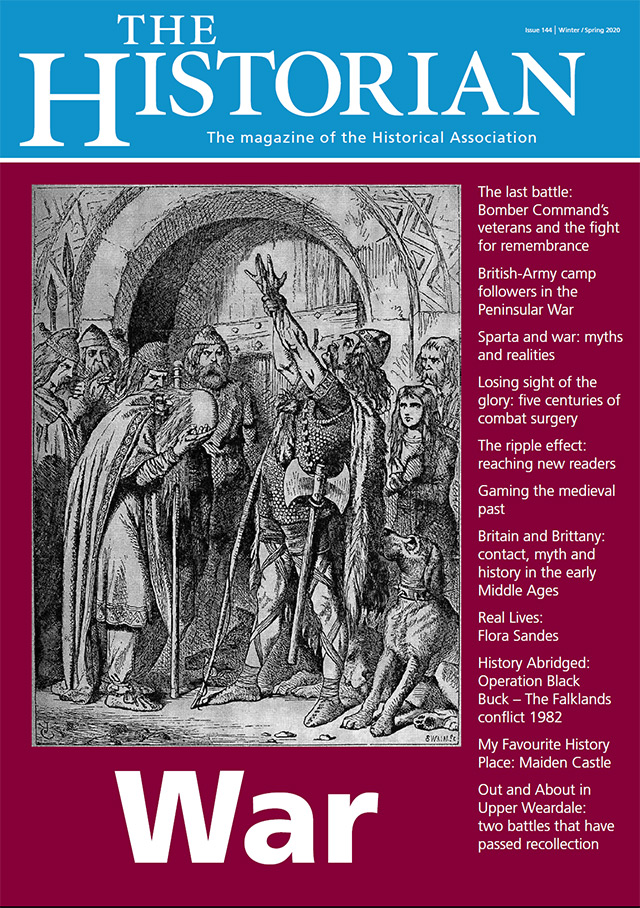The Historian 144: Out now

Editorial: War
War is such a small word for such a complex human activity and any research and publication that helps us to better understand it is welcome. I recollect a conversation with my local MP when the Conservative education secretary was proposing a new history curriculum that included the Boer War. ‘Which Boer War would you prefer?’ I asked. ‘The one with the heroic defence of Mafeking by Baden-Powell; the one where 38% of volunteers from industrial towns were judged medically unfit to serve; the one where an incompetent general left troops to be slaughtered on Spion Kop; or the one where 50,000 Boer and black African women and children died in concentration camps due to a callous lack of care?’
When I was an undergraduate I remember dipping into J.F.C. Fuller’s Decisive Battles of the Western World. What struck me most forcibly at the time was his thesis that the strength and techniques of an army are an expression of the society from which they arise. In the articles that follow this can be seen in a number of instances of individuals – the Spartan hoplites, the Saxon thegns, the Peninsular War camp followers, the bomber air crew – involved in conflicts, and it could have been the British and the Boers. I also think Fuller saw this more widely, war as the expression of a society, and that is the theme of this edition of The Historian, not necessarily how war is fought but how it is remembered, studied, used. That tells us about our own society as well as the past.
In her article Frances Houghton examines how and why popular memory of war continues to be contested in relation to the British bombing of Germany in the Second World War. Such events can be portrayed more positively as when omitting the German civilian casualties from the Dambusters story or more negatively when exaggerating the civilian casualties of the Dresden bombing. The truth of what actually happened continues to be fought over but now the weapons are statues and memoires as well as books and articles. The role of the historian remains one of trying to provide as accurate and full a version of events as the evidence permits; and also to challenge deliberate distortions. In his article Stephen Hodkinson explains how, from the evidence, Sparta’s militarism is a myth, a myth that has been appropriated by far right groups for their own purposes. In an age of populism the simple slogan has power. Taking a specific example Hodkinson points to the dubious claim that at Thermopylae the Spartan King Leonidas, when asked to surrender his arms replied, ‘Come and Get Them’, a phrase now being used as a rallying-cry by the US arms lobby.
In his article Charles Esdaile throws light on a vital part of a field army that receives relatively little study, the ‘baggage train’. In doing so he reveals more about wider society at the time, and in particular how women were viewed and treated. This strand can be seen in other articles too, the eighteenth century young women sailing with Captain Peirce to find husbands in India or the twentieth century young women of the ‘more intelligent sort’ playing war games. Matthew Bennett and Ryan Lavelle explore how the devising, playing and discussions of such war games can reveal the ‘cloud of unknowing’ in which the protagonists of the past operated. They also sound the cautionary note that the modern student of history finds understanding the mindset of that past difficult. They cite how their students wanted their eleventh century Saxon ealdormen to work together when the Anglo-Saxon Chronicle recorded, ‘one shire would not help another’. Meanwhile in the regular feature ‘Out and About’ Tony Fox introduces us to two battlefields, one involving men-at-arms, the other miners.
In contrast to these studies in depth Mick Crumplin traces developments in war surgery through time. He ranges from the medieval period to the twentieth century, detailing how new surgical techniques and advances can be directly attributed to changes in the conduct of war.
In wartime other aspects of life continue. The same is true for this themed edition on war; not every item is about war. In a timely article, Fiona Edmunds evidences the enduring links between Brittany and Britain through the Middle Ages, links that will no doubt continue into the future regardless of changing political structures. All of these authors are involved in spreading the fruits of their scholarship whether through formal teaching, further publications or lectures. One more, Philip Browne, tells his story of doing just this. Since the publication of his research he has been experiencing the lessons, trials and joys of talking to a wider audience than just historians.
It has been said that truth is the first casualty of war; but today we could argue that truth is a casualty of populism. The task of the historian then, whatever their area of expertise, becomes even more important. It becomes one of sharing their expert knowledge of the past as widely as possible and of debunking falsehood and distortions wherever they find them. This may not make historians popular, but it will make them relevant.

